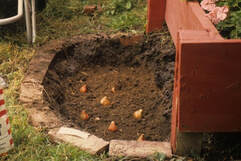
Choose an area with full sun to part shade. Ideally the soil should be a sandy loam, but if not, it can be amended by adding compost to a depth of at least one-foot. Incorporate fertilizer based on a soil test or use a 5-10-5 at a rate of three pounds per 100 square feet. The soil pH should be between 6.0 and 7.0.
Determine the planting depth based on the bulb size. Planting depth refers to the distance from the bottom of the hole, where the base of the bulb will rest, to the surface of the soil once the hole is backfilled. Bulbs the size of tulips and hyacinths are typically planted six-inches deep while daffodil-size bulbs should be six- to eight-inches deep. In general, bulbs should be planted two to three times as deep as their width. Space large bulbs four- to six-inches apart. Small bulbs can be spaced one- to two-inches apart. Mass plantings create a more aesthetically-pleasing display when spring blooms emerge.
Backfill each hole halfway and water in to settle the soil. Replace the remaining soil and water again. Though you will not see above-ground growth in the fall, roots are still growing. Keep the soil moist and add mulch after the soil freezes to provide insulation and prevent bulbs from being heaved out of the soil. (Cynthia Domenghini)
 RSS Feed
RSS Feed
